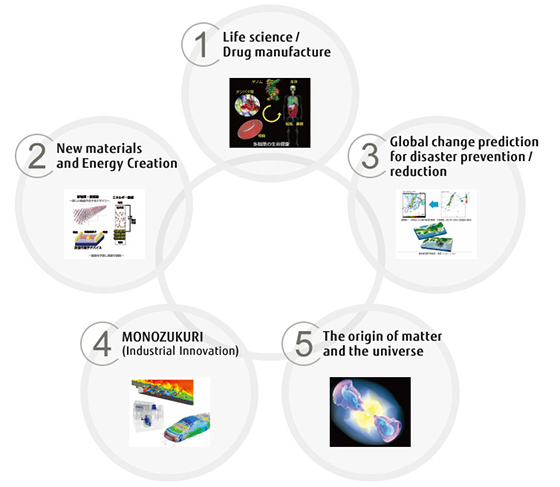Archived content
NOTE: this is an archived page and the content is likely to be out of date.
Five Strategic Fields

Field 1: Life science / Drug manufacture
Simulations will be performed to understand and predict new life phenomena in life-science computation, to support new drug developments that facilitate greater medical and pharmacological understanding, and to achieve predictable medical treatment. We can contribute to building a foundation for a healthy society by expanding the analysis of large-scale life data based on genome research, analyzing the behavior of biological macromolecules within cells, and conducting dynamic analysis of the layers comprising cells, organs and organisms.
[RIKEN (Collaborating organizations: School of Engineering / e Institute of Medical Science, e University of Tokyo, and others)]
Field 2: New materials and Energy Creation
Industry as we know it today is based on materials such as semiconductors and polymers that emerged from basic research. Thus the following activities will produce a torrent of industrial innovations in the future: ideas by which to search for new quantum phase and new materials, achieve a deep understanding of material functions, apply discoveries to the mainstream of basic science and next-generation electronic devices offering high functionality and performance, and the efficient generation of earth-friendly, renewable energy.
[Institute for Solid State Physics, e University of Tokyo, Institute for Molecular Science, National Institute of Natural Sciences, Institute for Materials Research, Tohoku University]
Field 3: Global change prediction for disaster prevention / reduction
By computing the movement of clouds on a global atmospheric scale, it becomes possible to accurately predict the path of a typhoon or a localized torrential downpour. Consequently, this will help us reduce the damage resulting from a disaster. Moreover, it will be possible to more accurately predict earthquakes and tsunamis, as well as to predict structural damage and the ramifications of complex disaster situations in which these elements are intertwined. This will establish the foundation for the next-generation mapping of earthquake and tsunami activity.
[Japan Agency for Marine-Earth Science and Technology (Collaborating organizations: Atmosphere and Ocean Research Institute / Interfaculty Initiative in Information Studies / Earthquake Research Institute, e University of Tokyo, Meteorological Research Institute, Tohoku University, and others)]
Field 4: MONOZUKURI (Industrial Innovation)
The new technologies may be created from large-scale but highly detailed analysis of complex phenomena. The combination of optimal technologies may be discovered that contributes to the development of new products that deal with critical future topics, such as resource recycling products. It may become possible to evaluate multifaceted characteristics--such as performance, efficiency, comfort, and reliability--by diagnosing the product as a whole, and thereby contribute to a new, more efficient manufacturing sector.
[Institute of Industrial Science, e University of Tokyo, Japan Atomic Energy Agency, Japan Aerospace Exploration Agency]
Field 5: The origin of matter and the universe
The mission of understanding is, for mankind, inextricably linked to the universe and our existence within it. Therefore, to unlock the origins of various materials or the complex structure of the universe, events from the big bang up to the current day will be recreated through numerical simulations, and the future will be predicted. Using the fundamental equations of physics, elementary particles atomic nuclei, atoms and molecules, as well as stars, interstellar matter and dark matter, are described. This will reveal the true character and mystery of birth, both in the outer sphere and our own life.
[Center for Computational Sciences, University of Tsukuba, High Energy Accelerator Research Organization, National Astronomical Observatory of Japan]
- New insights through computer simulations
- Nurturing next-generation scientists
- Five Strategic Fields




